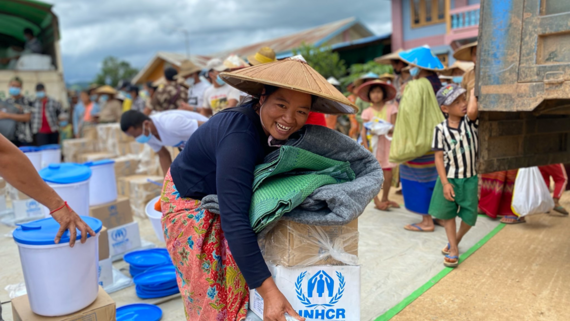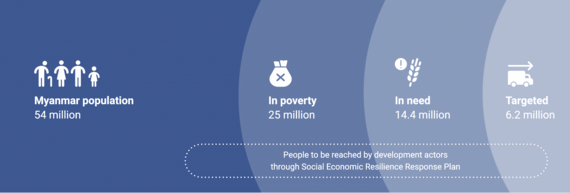Analysis of the context, crisis and needs
The people of Myanmar are facing an unprecedented political, human rights and humanitarian crisis, with needs escalating dramatically since the military takeover and a severe COVID-19 third wave in 2021. This has generated new needs in new areas with increased displacement due to the spread of conflict. The military takeover and the large-scale civil disobedience movement that followed have heavily impacted the already fragile public service sector, further restricting the access of people in need to basic services. The twin crises of COVID-19 and the military takeover have also deepened pre-existing needs among already vulnerable groups, including stateless Rohingya people and protracted IDPs in the country’s north-east. New needs have also been identified as a result of the new national frame of analysis that uses food insecurity as a measure to vulnerability.

Yangon, Myanmar
A family have lunch at their home in an informal settlement in Hlaingtharyar Township, Yangon. A combination of the pandemic and civil unrest, following the February 2021 military takeover is pushing Myanmar’s economy and the most vulnerable people into financial distress and worsening food insecurity. Food prices are increasing and food availability is becoming limited in conflict-affected areas.
WFP/Kaung Htet LinnThe economic and political turmoil of 2021 has combined to drive almost half the population into poverty, wiping out gains made since 2005. Increasing numbers of vulnerable people are exhausting their coping capacity and are now slipping into humanitarian need. Price hikes, COVID-19 movement restrictions and ongoing insecurity have forced the most vulnerable people to resort to crisis or emergency coping mechanisms to access food and basic services. Prices for key household commodities have increased significantly, making food unaffordable for many. Monsoon floods in July and August 2021 hit communities already in need of humanitarian assistance in various parts of the country, resulting in loss of crops and increased food insecurity. This multidimensional humanitarian crisis is now affecting the whole country, posing grave protection risks for civilians, limiting access to services and deepening food insecurity. This requires a broader national needs analysis and a scaled-up humanitarian response to stop people slipping into life-threatening need.
Projected situation in 2022 and beyond
The political, socioeconomic and protection crisis in Myanmar is fuelling growing humanitarian needs. The outlook for 2022 remains dire, with the key drivers of need – conflict, COVID-19, economic stress and statelessness – all continuing to negatively affect the population. The political and security situation is expected to remain volatile, with increased displacement anticipated. The devastating third wave of COVID-19 appears to be breaking as 2021 draws to a close. However, a damaging fourth wave due to low vaccination rates is a significant risk in 2022. Associated COVID-19 precautions and restrictions are likely to be a continuing factor for the people of Myanmar and the response in 2022. The general trend of price hikes of basic food items and agricultural inputs is expected to continue, reducing food affordability.

Shan State, Myanmar
A woman at an aid distribution point in Myanmar’s Shan State, where people receive relief items.
Relief InternationalWomen, children and people with disability are particularly vulnerable amid this economic and protection crisis, exposing them to risks of exploitation and abuse, including sexual and gender-based violence. Learning has been disrupted for almost 12 million children due to widespread COVID-19 school closures. Needs that were unmet in 2020 and 2021 because of access constraints have directly contributed to escalating needs heading into next year.
The expanded nature of the crisis has prompted the Humanitarian Country Team to apply a wider national vulnerability lens to the needs analysis. In the absence of national multisectoral needs assessments, food insecurity data was mostly used as a proxy basis for determining intersectoral vulnerability. The joint intersectoral analysis process identified 14.4 million people in humanitarian need in Myanmar in 2022. It is important to note that figures for 2022 are not comparable to previous years due to the change in scope and methodology.
Response priorities in 2022
After a significant scale-up to respond to new needs after the military takeover, the humanitarian community expects to have reached 2.2 million people out of 3 million targeted for assistance by the end of 2021. This wider reach is predominantly the result of increased food distributions in new conflict areas and urban locations. Humanitarian organizations stand ready to further step up their efforts and have set an ambitious target of assisting 6.2 million people in 2022. Humanitarian partners require US$826 million to support this more ambitious programme covering new people in new areas. The financial ask is more than double the requirement in 2021. This is a reflection of deeper needs being observed, a wider response being planned, inflation and increased cost of delivery.
Myanmar HRP
The focus of the 2022 response will be to save lives and improve the overall health and mental and physical well-being of people affected by COVID-19, conflict and natural disasters through timely and integrated assistance. Vulnerable people’s living standards will be improved and their resilience strengthened. Partners will work to ensure that protection risks are mitigated, protection needs are monitored and met, and respect for international humanitarian law is promoted. Targeting will be continuously reviewed and refined with the possibility of a further revision in the first half of 2022.
The expanded response will require improved access and reduced red tape. Access to affected people for the delivery of assistance and people’s access to life-saving services and support remains limited in many parts of the country, with constraints being most severe in areas of active conflict where there is now a heavy reliance on support from local and national partners. Staff safety in these areas is a serious concern due to active fighting, landmines, intimidation and threats. Bureaucratic impediments are also affecting the pace and effectiveness of the response, and COVID-19 movement restrictions have limited access.
Further reading
Source: Office for the Coordination of Humanitarian Affairs
Source: Humanitarian Insight
Source: Financial Tracking Service




